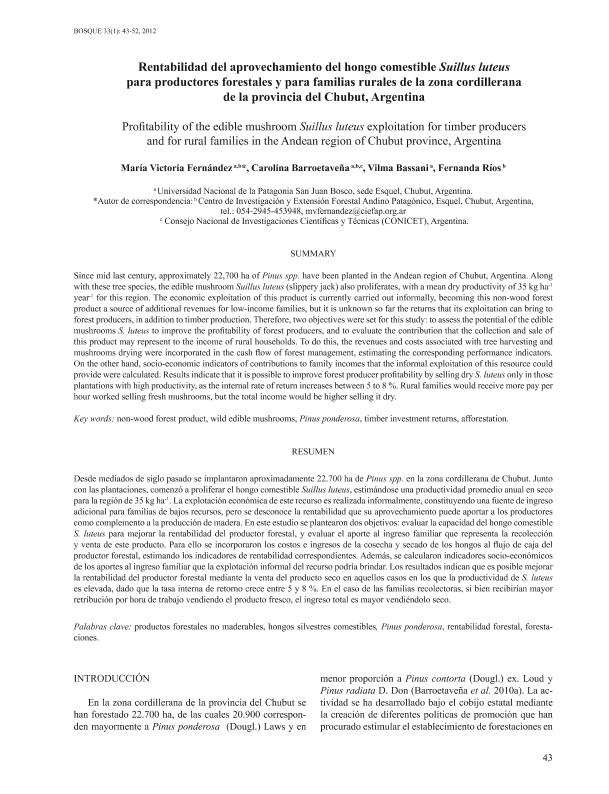Artículo
Since mid last century, approximately 22,700 ha of Pinus spp. have been planted in the Andean region of Chubut, Argentina. Along with these tree species, the edible mushroom Suillus luteus (slippery jack) also proliferates, with a mean dry productivity of 35 kg ha-1 year-1 for this region. The economic exploitation of this product is currently carried out informally, becoming this non-wood forest product a source of additional revenues for low-income families, but it is unknown so far the returns that its exploitation can bring to forest producers, in addition to timber production. Therefore, two objectives were set for this study: to assess the potential of the edible mushrooms S. luteus to improve the profitability of forest producers, and to evaluate the contribution that the collection and sale of this product may represent to the income of rural households. To do this, the revenues and costs associated with tree harvesting and mushrooms drying were incorporated in the cash flow of forest management, estimating the corresponding performance indicators. On the other hand, socio-economic indicators of contributions to family incomes that the informal exploitation of this resource could provide were calculated. Results indicate that it is possible to improve forest producer profitability by selling dry S. luteus only in those plantations with high productivity, as the internal rate of return increases between 5 to 8 %. Rural families would receive more pay per hour worked selling fresh mushrooms, but the total income would be higher selling it dry. Desde mediados de siglo pasado se implantaron aproximadamente 22.700 ha de Pinus spp. en la zona cordillerana de Chubut. Junto con las plantaciones, comenzó a proliferar el hongo comestible Suillus luteus, estimándose una productividad promedio anual en seco para la región de 35 kg ha-1. La explotación económica de este recurso es realizada informalmente, constituyendo una fuente de ingreso adicional para familias de bajos recursos, pero se desconoce la rentabilidad que su aprovechamiento puede aportar a los productores como complemento a la producción de madera. En este estudio se plantearon dos objetivos: evaluar la capacidad del hongo comestible S. luteus para mejorar la rentabilidad del productor forestal, y evaluar el aporte al ingreso familiar que representa la recolección y venta de este producto. Para ello se incorporaron los costos e ingresos de la cosecha y secado de los hongos al flujo de caja del productor forestal, estimando los indicadores de rentabilidad correspondientes. Además, se calcularon indicadores socio-económicos de los aportes al ingreso familiar que la explotación informal del recurso podría brindar. Los resultados indican que es posible mejorar la rentabilidad del productor forestal mediante la venta del producto seco en aquellos casos en los que la productividad de S. luteus es elevada, dado que la tasa interna de retorno crece entre 5 y 8 %. En el caso de las familias recolectoras, si bien recibirían mayor retribución por hora de trabajo vendiendo el producto fresco, el ingreso total es mayor vendiéndolo seco.
Rentabilidad del aprovechamiento del hongo comestible Suillus luteus para productores forestales y para familias rurales de la zona cordillerana de la provincia del Chubut, Argentina
Título:
Profitability of the edible mushroom Suillus luteus exploitation for timber producers and for rural families in the Andean region of Chubut province, Argentina
Fecha de publicación:
02/2012
Editorial:
Universidad Austral de Chile. Facultad de Ciencias Forestales
Revista:
Bosque (Valdivia)
ISSN:
0304-8799
e-ISSN:
0717-9200
Idioma:
Español
Tipo de recurso:
Artículo publicado
Clasificación temática:
Resumen
Archivos asociados
Licencia
Identificadores
Colecciones
Articulos(SEDE CENTRAL)
Articulos de SEDE CENTRAL
Articulos de SEDE CENTRAL
Citación
Fernandez, Maria Victoria; Barroetaveña, Carolina; Bassani, Vilma; Rios, Fernanda; Rentabilidad del aprovechamiento del hongo comestible Suillus luteus para productores forestales y para familias rurales de la zona cordillerana de la provincia del Chubut, Argentina; Universidad Austral de Chile. Facultad de Ciencias Forestales; Bosque (Valdivia); 33; 1; 2-2012; 43-52
Compartir
Altmétricas




